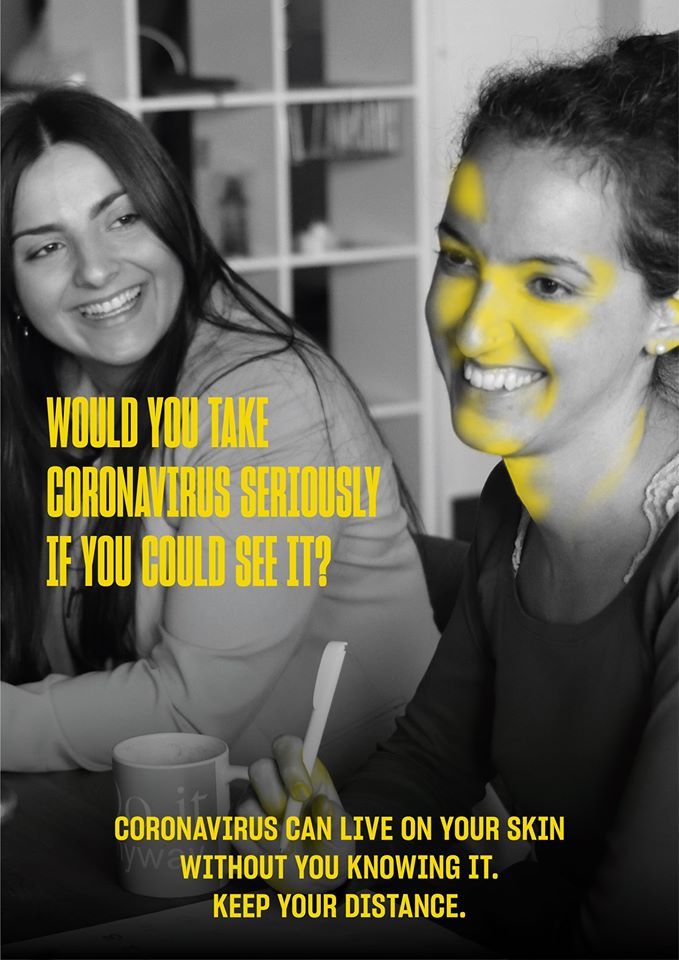Coronavirus danger isn't there for all to see
Mike Crutchley • 21 April 2020
People would be more careful if they could see the risks

Throughout the coronavirus pandemic, it has amazed me that people are still taking risks and even ignore social distancing altogether. A poster a friend designed for the World Health Organisation made it obvious what the problem is.
Understanding
It’s in our nature that we want to know how things work and why we should or should not do something. Few of us respond well to direct orders and, in all honesty, are probably more likely to act in defiance if we have just been given an instruction with little or no explanation.
When Boris Johnson first announced the UK’s social distancing measures, he did not use the word lockdown, didn’t force businesses to close and simply asked people to stay away from social settings.
The reasons given for the soft approach were that the longer people faced restrictions, the less likely they would be to comply with them and the government stressed that it also wanted to protect the economy.
But the warning and the tone of it failed to convey the seriousness or urgency of what we were facing. Had we been shown posters such as the striking ones my friend designed, the importance of social distancing might have hit home straight away and to a wider audience.
Hidden threat
The problem with the virus was that people couldn’t see it and couldn’t see the destruction it was causing.
The naked eye cannot see cancer or other viruses such as HIV, but we can see the damage and deterioration they cause as people’s conditions worsen and they eventually lose their battle with a disease.
But with Covid 19, due to isolation and quarantine – and because of common decency and respect for privacy – we have not publicly been shown the full effect this disease has on the human body. We have not seen – and nor should we see – images and videos of people in agony, struggling to breathe and, ultimately, dying.
As well as huge loss of life, the subsequent measures taken have affected livelihoods as well as people’s mental health.
The government also made mistakes, as highlighted in an excellent article in The Observer*, which highlights the lack of a long-term strategic plan to deal with an outbreak. To simply expect people to follow draconian rules to tackle something they cannot see requires a huge leap of faith.
And, as the dire UK weather improved just as restrictions were being introduced, many people simply made the most of it. And when people knew social distancing measures were about to become stronger, they packed pubs and restaurants to enjoy their final hours before lockdown, again exposing themselves to the risk of infection.
U-turn
When the government did finally step up its measures for delaying the spread of the virus, a lot of damage had already been done. With tens of thousands infected, and more than 17,000 already dead, the UK could be on course to have one of the worst Covid-19 records in Europe.
While most people are now playing their part in containing the outbreak, they look on in shock and amazement at reports from the US that President Trump is urging people to ignore the lockdown there and get back to life as normal.
I’m not sure whether my friend had Mr Trump’s likely response in mind when he designed one of the posters, but the message is clear and certainly very apt given the current situation. It is also a warning that needs to be heeded by the thousands who are flouting restrictions there. They need to realise the risks to themselves and others.
In a parallel universe, most children returned to school this week after enjoying their Easter break, with adults returning to work and looking forward to the next family break. The reality is somewhat different .
* https://www.theguardian.com/world/2020/apr/18/how-did-britain-get-its-response-to-coronavirus-so-wrong?CMP=Share_iOSApp_Other&fbclid=IwAR0hgMRR0K-PcSkTpOwTFRoryIwO5LWOdLbGMsD6NM9nA14rhjBGuK1CrNM
